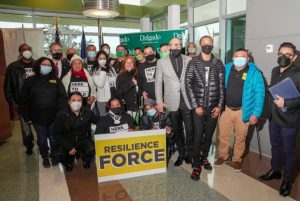Few labor organizers tell stories as skillfully as Saket Soni.
Originally from New Delhi, Soni enrolled in the University of Chicago at 18 to learn how to write plays. “I think my parents may have been the only ones in Indian history to let their son come to the United States to study theater,” he says.
But a paperwork mishap left him undocumented after graduation, leading him to start volunteering for community groups – until he got a work visa as a staff organizer two years later. This career led him to the center of a very different kind of drama: one of the largest human trafficking operations in modern US history.
That’s the subject of Soni’s gripping debut book, The Great Escape, which recounts a years-long struggle for justice in the form of a taut thriller. After Hurricane Katrina, a green card scam tricked hundreds of Indian workers into handing over their life savings to join what ended up being a Mississippi labor camp. Soni has paired his recollections of the events with stunning new discoveries about the case – including the motivations of the Immigration and Customs Enforcement (Ice) agent who hunted the Indian men.
Today Soni directs a non-profit called Resilience Force, which advocates for the immigrant workers who are backbone the US’s growing climate change industry. I spoke to him about the writing process for his new book, and how the story reveals an America that still hasn’t outgrown its worst demons.

Saket Soni in LaPlace, Louisiana, last year. Photograph: Josh Brasted/Getty Images for Resilience Force
The Great Escape is an incredible story, with corporate greed and government collusion trapping hundreds of Indian workers in an American hellscape they never imagined. How did you get tangled up in this?
Saket Soni: The story starts with a mysterious midnight phone call that I received on my 29th birthday. I was a labor organizer in New Orleans at the time, months after Hurricane Katrina had destroyed large parts of the Gulf coast. There were almost a million homes to be rebuilt in Louisiana, and nearly that many in Mississippi. It was the world’s largest construction site, largely being staffed by immigrant workers. And my job was to protect them.
The man who called was clearly from close to my home town, somewhere in north India, and he sounded desperate. Most workers I was helping at the time were from Central and South America. I wondered: how on earth did he end up here?
What I discovered was that he was one of 500 Indian laborers who had been convinced to pay $20,000 apiece to come to the US on legal guest worker visas to rebuild storm-damaged oil rigs, on false promises that they could become green cards – the American dream. The workers had raised that money by selling ancestral land and taking high-interest loans. Turns out they’d been dropped into an American nightmare. They arrived into a barbed wire labor camp, where they were forced to pay $1,000 a month to live 24 people to a room, in trailers placed on top of a dump. They were fed frozen rice and moldy bread. And there were never any green cards.
So it was just pure exploitation.
The company got these incredibly skilled workers at a fraction of the cost of US workers; the recruiters earned millions, and the workers now were trapped inside the camp in a condition of debt servitude. Money lenders were circling their families, and the men and no choice but to stay and work. They needed my help. And that’s when I encountered a man named Rajan, who became my organizing partner, friend and co-engineer of the great escape at the center of the book.
I still can’t get over the fact that you managed to sneak hundreds of Indian men past armed guards out of a gated labor camp in southern Mississippi. How did you do that?
Without giving away all the details, over the course of months, we orchestrated this escape that was almost out of a heist film. It started with me smuggling Indian ingredients into the camp for Rajan, who took over the cafeteria and cooked these extraordinary meals that nursed the men out of their blank hopelessness into an appetite for something better.
The escape involved a lot of whiskey, cigars, as bribes for the guards, and then an elaborate but fictitious Indian wedding that let us ferry 500 men out of the labor camp into a hotel room, right under the guards’ noses.

These men were taking a leap of faith that you could help them win justice. Did you realize what a brutal journey you were signing them up for?
We filed a criminal complaint with the Department of Justice alleging human trafficking that we believed would trigger an investigation and lead to indictments, and unlock humanitarian protections for the men that would come with work permits.
These men had incredible faith in American institutions, more than most people I’ve met who were born in America. They would say, “Sure, an American company enslaved us, but the American government is there for us – we’re going to get justice.” In their English, they’d tell me: “It’s right there in the name, the Department for Justice.”
What we didn’t know at the time was that we were up against an Ice agent with corrupt ties to the company, with personal reasons to cover up the company’s scheme and deport the men. When that became clear, we all realized this was going to be a much longer fight – and it took the better part of four years.
Human trafficking is a heavy topic. As someone who often writes about labor, I know how hard it is to describe fights that involve layers of policy – yet your book reads like thriller novel the whole way through. How did you do it?
I was trying not to feed you your vegetables. I wanted to write something that you couldn’t put down. And so I decided to kind of study all kinds of fiction in all kinds of genres. You know, I read Raymond Chandler, potboilers, detective stories, watched noir cinema, to learn how to tell a story that is propulsive and packed with adrenaline. I followed an ironclad rule that that the book had to be scenic. And every scene had to have people entering into a war of intentions that moved the drama forward. The goal was to hang a human trafficking story on the plot structure of a great crime novel. It also is rigorously nonfiction. Everything in it is true.
Thankfully, the campaign had strong characters and a strong plot and more than enough revelry to go around. Despite the human trafficking story in a labor camp in Mississippi, there was so much audacious joy that shaped these men. In one scene, one of the workers learns his son has just been born, 10,000 miles away in India. He does everything a father would do in an Indian village, but just in a camp in Mississippi: he gets whiskey, he gets the camp cook to cook him the closest approximation of party food in India, chicken 65. And he distributes it to the camp guards, who can’t keep him confined that night. That kind of joy that bursts out of the labor camps was the flavor that I wanted to pack the book with.

You write intimately about your characters. We’re with them at their most beautiful and ugliest moments. We learn about their heartbreaks, their dreams and their secret fears. How did you get so close?
I was in a foxhole with these men. But when it came time to write the book, I needed to get to know them in a very different way. When you’re an organizer, you’re in action mode, you’re preparing people to give congressional testimony. You talk about the plight of the workers, and how much they deserve, support and help. A lot of their interiority doesn’t have space, doesn’t fit into the application for a humanitarian visa, or the two minutes you have to speak to Congress.
In books, you know, people need characters who are complex and flawed and growing. You know, the immigrants in this book are not angels. Their motivations are complicated. So I had to get to know them very deeply all over again, in a very different way. We did dozens of trips and years of interviews, often over extraordinary meals that inspired memory. I got to know their love stories and their heartbreaks.
The surprising thing to me was that the non-immigrants in the book – the labor recruiters, company officials, a guard who kept the workers confined, and even, to my astonishment, the Ice agent at the center of the book, who had been my arch-nemesis – all of these people agreed to talk. And so I was also able to build them out as complex, full human beings and characters.
There’s a political critique that runs through this book about the way these men are bounded by global capitalism. We watch as no one is willing to take responsibility: not the Indian government, not American labor unions. Is there something fundamentally broken about the program that brought the workers here in the first place?
Guest worker programs are a complete failure in the United States. They are constructed without protections, they hurt immigrant workers, they even hurt employers who want to do better, but only have the guest worker program. These programs also hurt the US workers who work alongside the immigrants – these workers are used to undercut wages and conditions. It’s not a coincidence that the scheme trafficked these workers in the Trojan horse of the perfectly legal guest worker program. It’s rife with abuse and can be co-opted to do this kind of harm.
But the deeper critique is that the entire lineage of this program is immoral. Congress recognized the injustice of the Bracero program, the program that imported a million Mexican workers into conditions close to slavery in the United States. Before that, there were other indentured servitude programs to provide forced labor, and of course, slavery. So a Mississippi labor camp is a story as old as America, right? The problem is that every generation forgets these chapters in American history, and goes on to invent the next version.

Resilience Force workers in New Orleans last year. Photograph: Josh Brasted/Getty Images for Resilience Force
I finished your book just as Joe Biden announced the return to some Trump-era migrant detention policies – we don’t seem to learn from our mistakes. What makes you believe that things can actually get better?
When I met the workers at the center of this book, what I didn’t know was that they were among the first members of a rising workforce being created because of climate change. At Resilience Force, when workers follow storms, we follow workers, to often deeply conservative places across America where they’re rebuilding. And friendships emerge between the people who thought they hated immigrants, but now are depending on immigrants to rebuild their towns.
There was a family in Florida a few years ago – I watched as a hurricane blew away their roof. While waiting for Fema, they put up a sign that said “strangers will be shot”. Well, strangers did arrive to their home: a band of immigrant workers. We rebuilt their home. And at the end, we got together for dinner, the friendship flourished – and they took the sign down.
The truth is that what I see in real life after disasters is this profound opening to build new social cohesion in America and across the world. And ultimately, that gives me a lot of hope.
- The Great Escape: A True Story of Forced Labor and Immigrant Dreams in America is published by Algonquin Books
This interview has been edited and condensed for brevity and clarity
Click here to learn more about Resilience Force
Click here to purchase The Great Escape: A True Story of Forced Labor and Immigrant Dreams in America
